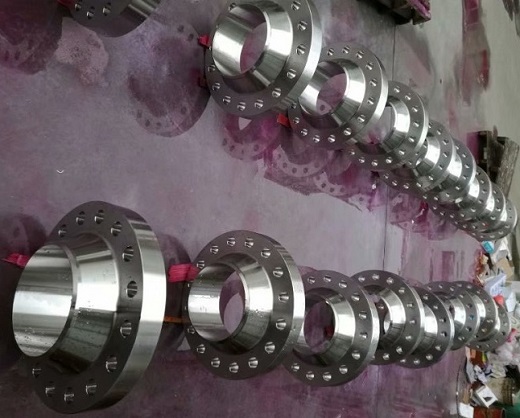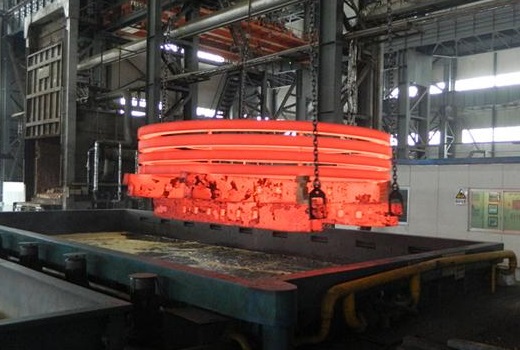Product Categories
- Products (61)
The hot forging process for a duplex stainless steel weld neck (WN) flange, made from ASTM A182 F51/ UNS S31803. WNRF 24" SCH80 Class 600, ASME B16.5.
Both ASME B16.5 and ASME B16.47 have endorsed pipe flanges made from a series of duplex stainless steel grades. These grades include forgings of ASTM A182 Grade F51, Grade F53, Grade F55; castings of ASTM A995 Grade CE8MN, Grade CD4MCuN, Grade CD3MWCuN; and plates of ASTM A240 Grade S31803, Grade S32750, and Grade S32760. Duplex stainless steel plates can only be used for the manufacture of blind flanges and plate flanges without hub. ASTM A182 F51/ UNS S31803 is classified as standard duplex stainless steel while ASTM A182 F53/ UNS S32750 & ASTM A182 F55/ UNS S32760 are classified as super duplex grades.

Weld neck flanges made of ASTM A182 Gr. F53 (UNS S32750); 12″ 300# SCH80; dye penetration inspection was conducted; supplied to a Singapore client.
Duplex stainless steel flanges manufactured in accordance with ASME B16.5 are available in sizes 1/2″~24″ from Class 150 through Class 2500. For ASME B16.47 Series A, they are available in sizes 26″ to 60″ and in Class 150 through Class 900; For ASME B16.47 Series B, they are available in sizes 26″ to 60″ and in Class 75 through Class 900. The flanges may be furnished in any type as specified in the standard specification. Tailor-made types are also available upon customer’s request.
Duplex stainless steels have a mixed structure of body-centered cubic (BCC) ferrite and face-centered cubic (FCC) austenite. The exact amount of each phase is a function of composition and heat treatment or heat history. However, most duplex stainless steels are commonly considered to have roughly equal amounts (volume fractions) of ferrite and austenite. The principal alloying elements are chromium and nickel, but nitrogen, molybdenum, copper, silicon, and tungsten may be added to control structural balance and to impart certain corrosion-resistance characteristics. The corrosion resistance of duplex stainless steels is like that of austenitic stainless steels with similar alloying elements. However, duplex stainless steels possess higher tensile and yield strengths and significantly greater resistance to chloride SCC (stress corrosion cracking) than their austenitic counterparts. They also exhibit improved toughness than ferritic stainless steels.
Chromium, molybdenum, nitrogen, and nickel are the most important alloying elements which have significant effects on the mechanical, physical and corrosion properties of duplex stainless steels.
Chromium is necessary to form a stable chromium passive film that is sufficient to protect the steel against mild atmospheric corrosion. The higher content the chromium, the greater the corrosion resistance. Chromium is a ferrite former, meaning it promotes the BCC structure of iron. It also increases the oxidation resistance at elevated temperatures. Higher chromium also promotes the formation of intermetallic phases, which are detrimental to the duplex stainless steel and shall be addressed. Molybdenum enhances the resistance to both pitting corrosion and crevice corrosion. However, it is usually restricted to less than 4% in duplex stainless steels since Mo is also a ferrite former and may lead to detrimental intermetallic phases. Nitrogen increases the pitting and crevice corrosion resistance. It also substantially increases the strength as the most effective solution strengthening element. Nitrogen is a strong austenite former, the addition of which improves the toughness of the duplex greatly. It also delays the formation of intermetallics enough to permit processing and fabrication of the duplex grades. Nickel is an austenite stabilizer and it promotes the formation of austenitic FCC structure, which is responsible for the improved toughness of duplex grades.

The quenching of duplex stainless steel ring flanges. The quenching shall be done immediately after the flanges leave the furnace.
For duplex stainless steel flanges, solution annealing at an appropriate temperature followed by immediate water quenching gives the best metallurgical austenite-ferrite phase balance. It is important to keep the time between exiting the furnace and water quenching as short as possible. This is to minimize heat loss of the flange which could lead to detrimental phase precipitation before water quenching to room temperature.
All above mentioned duplex stainless steels are classified as Group 2.8 materials. The pressure-temperature ratings these materials are listed in the tables below. The tabulated values represent maximum allowable working gauge pressures (in psi units) at the temperature (in degrees Fahrenheit). For intermediate temperatures, linear interpolation is permitted. Important Note: since duplex stainless steels may be subject to embrittlement after service at moderately elevated temperatures, they are not allowed to be used over 600°F [315°C].
| Temp. °F | Working Pressure by Classes, psi | ||
| 75# | 150# | 300# | |
| -20~100 | 145 | 290 | 750 |
| 200 | 130 | 260 | 745 |
| 300 | 115 | 230 | 665 |
| 400 | 100 | 200 | 615 |
| 500 | 85 | 170 | 580 |
| 600 | 70 | 140 | 555 |
| 650 | 60 | 125 | 545 |
| 700 | - | 110 | 540 |
| 750 | - | 95 | 530 |
| Temp. °F | Working Pressure by Classes, psi | ||
| 400# | 600# | 900# | |
| -20~100 | 1000 | 1500 | 2250 |
| 200 | 990 | 1490 | 2230 |
| 300 | 890 | 1335 | 2000 |
| 400 | 820 | 1230 | 1845 |
| 500 | 775 | 1160 | 1740 |
| 600 | 740 | 1115 | 1670 |
| 650 | 730 | 1095 | 1640 |
| 700 | 725 | 1085 | 1625 |
| 750 | 710 | 1065 | 1595 |
| Temp. °F | Working Pressure by Classes, psi | |
| 1500# | 2500# | |
| -20~100 | 3750 | 6250 |
| 200 | 3720 | 6200 |
| 300 | 3335 | 5560 |
| 400 | 3070 | 5120 |
| 500 | 2905 | 4840 |
| 600 | 2785 | 4640 |
| 650 | 2735 | 4560 |
| 700 | 2710 | 4520 |
| 750 | 2660 | 4430 |
Duplex stainless steel flanges have found widespread use in a range of industries, particularly the oil and gas, petrochemical, pulp and paper, and pollution control industries. They are commonly used in aqueous, chloride-containing environments and as replacements for austenitic stainless steels that have suffered from either chloride SCC or pitting during service. Generally, duplex stainless steel flanges can be used for the construction of heat exchangers, chemical tanks, reactors, flue gas filters and other pressure equipment. Especially, super duplex grades (S32750 & S32760) are resistant to oxygenated or chlorinated seawater. Flanges made of ASTM A182 F53 or F55 can be used in seawater desalination systems.
